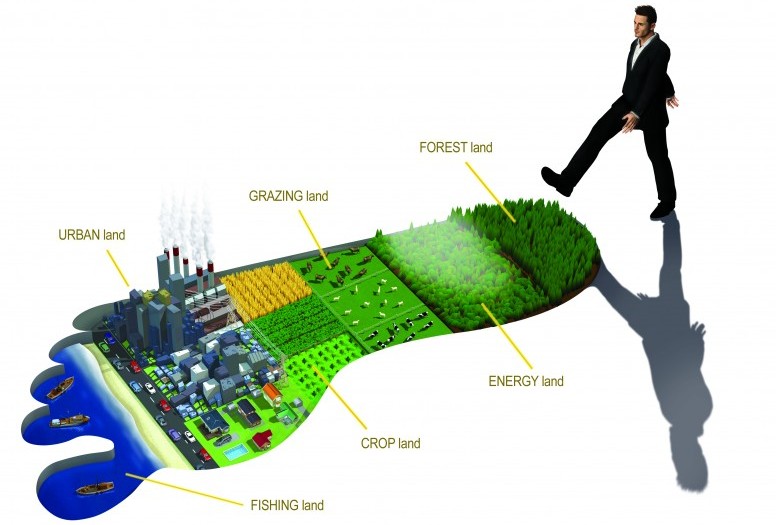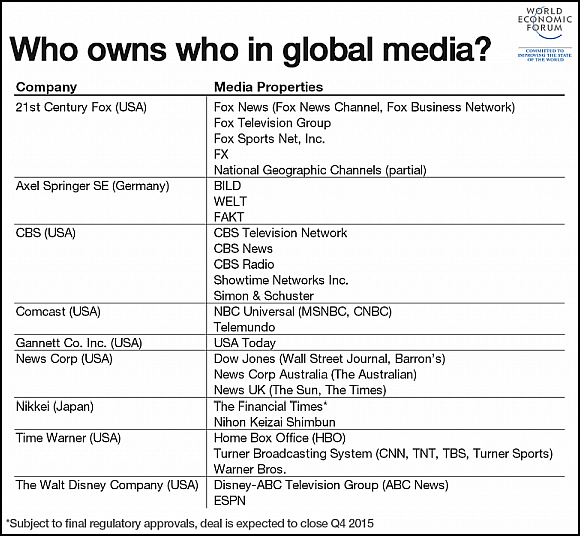CGW4U
World Issues: A Geographic Analysis
Unit 4: Environmental Sustainability
Activity 1: How do our consumer choices affect people in LEDCs?
Let’s imagine that you have just won a lottery and it’s a pretty good size, maybe 5 or 10 million dollars.
What would you do? Save some of it? Invest some of it? Give some to a charity you think is doing really good work? Buy a car, some jewelry, go on a trip?
Heck, with that much money you could afford to do all of these things!
In this activity we will see how some of these everyday actions contribute to consumerism and ultimately to globalization.
Before you think any further about how you would spend a lottery windfall, complete the Footprint Calculator questions at the Global Footprint Network to measure your current Ecological Footprint (EF).
Your ecological footprint is a measure of all the things nature needs to provide you with for your lifestyle, and also the amount of space necessary to absorb the waste and pollution your lifestyle creates. EF is measured in the number of hectares (ha) it would take to provide for everything in your lifestyle.
 Ecological Footprint Comparison
Ecological Footprint Comparison
Record the information that is on the last screen of the Footprint Calculator. Be sure to also record the average EF for Ontario so that you can compare your EF to that of the province so that you have a concept of how you fall on the spectrum.
What, if any, of your result was a surprise? Had you ever thought of your lifestyle in these terms? What does it really matter if your EF is large or small? To get a more global view of EF read “Average human's ecological impact on the planet shrinking, study suggests” and watch the following video, “Do we fit on our planet?”
If you want to visit any links in the following pdf, right click and select "Open Link in New Tab" to avoid leaving this page.
 Resources
Resources
To see the differences around the world we can also use the following resources:
-
The cost of living in every country in the world in a single, awesome infographic (Click on the thumbnail maps to view full images).
-
Peter Menzel’s photography from his 1994 ‘Material World: A Global Family Portrait.’ Check out the original images for an MEDC and LEDC. These images were published in 1994. Be sure to also look at the “Revisiting” image at the bottom of the collection to see the American family in 2000.
 Issues Café: Ecological Footprint
Issues Café: Ecological Footprint
Look at the American family by following the link in #2 above and assess how this image from the year 2000 would need to change to more accurately reflect a North American family today.
While Peter Menzel did not photograph a Canadian family, speculate on the differences that you might see between an American and Canadian family.
Have you ever stopped to think about how connected you are to the rest of the world? Any of the ways that people might choose to spend their lottery winnings, or for that matter the ways we spend our paycheck, results in globalization. Globalization can be seen and felt environmentally and socially.
Let’s go back to our lottery winner for a moment. One of the most common ways people celebrate a lottery win is travel. One specific way the decision to travel impacts the globe is by increasing climate change.
One of the “hot” new locations for travel is the Arctic. The melting of the polar ice cap has opened the Arctic Ocean in a way like never before. It is also opened it for shipping and China, among other countries, is very interested in this new route to the consumers of their manufactured goods.
What social and environmental impacts will cruise ships, cargo tankers and military ships have as they go through this region?
 My Questions
My Questions
As you review the articles and video, make note of any questions you have for future reference.
While the Crystal Serenity appears to take all the necessary precautions, there is complete agreement that there will still be environmental impacts. Read about the impacts of climate change for this Canadian territory.
What questions came to mind as you read these articles? Perhaps you were thinking along the same lines as some of the questions below.
- Do consumers, who are willing to pay up to $120,000.00 to travel through the region, have a right to this experience?
- Can governments block this kind of activity?
- Should wealthy people from other parts of the world be able to exploit the people and environment of the high Arctic?
- How much will this exacerbate climate change?
- Should countries within the Arctic protect their sovereignty or should the changes occurring benefit the world?
The current question regarding Arctic cruises is all about money! If you have enough money to buy a ticket, the cruise is yours. All stakeholders agree, however, that this opening of the Northwest Passage may also mark the beginning of visitation that will not take the cultural and environmental precautions that Crystal Serenity appear to be taking now. The future cruises may become more affordable, but the people and the environment of the Arctic will pay for this cheaper cruise though increased climate change, pollution and abuse of Arctic peoples and their cultures.
Canadian, Naomi Klein, has spent years looking at the issue of climate change. In her book This Changes Everything she questions if we can achieve climate change targets within the economic structure of capitalism. Is there a different economic system that would better allow us to move from our dependence on fossil fuels toward clean and sustainable future?
What about if we look at an LEDC, would your answers to any of these questions about tourism in environmentally sensitive areas be different?
If you want to visit any links in the following pdf, right click and select "Open Link in New Tab" to avoid leaving this page.
 Summaries
Summaries
Summarize both the article and video. Also record a summary of Klein’s arguments.
Climate Change
Take a moment to analyse the significance of this video about climate change being funded by a car company...do you have any concerns now that you know this fact?
One million tourists annually, waste, wastewater, closed desalination plant and the eventual flooding of your nation… this is reality of life in the Maldives. Read more about the Maldives to learn about one proposal for their future.
There is no question, climate change is hardest on LEDCs. The environmental price paid by tourists cruising through the Arctic archipelago or snorkeling around the Maldives is incredibly high. When is it too high?
 Rights of the LEDCs
Rights of the LEDCs
Consider the rights of LEDCs. Should the desires of the MEDCs be blocked due to the impacts felt in the LEDCs?
Globalization is not only felt environmentally. It also impacts local cultures. Travel is one of the forces that cause cultural globalization. We can see this in the loss of unique cultures and the assimilation of other cultures into the western aesthetic. Globalization of culture however, is not just characterized by western tourists visiting remote or less developed areas. Sometimes the process is more subtle.
Culture includes shared traditional food, language, literature, clothing, art and value system of a people. Culture is learned, and is passed down from generation to generation. Most cultures are not static and adapt to the current times.
Media
What we see on TV, and to a similar extent on our social media feed, comes from sources in MEDCs. According to the World Economic Forum, all major media corporations come from MEDCs, in particular the USA, Germany and Japan. Their ability to influence the world’s LEDCs is immense.
Cultural influence can be as subtle as the clothing worn by newscasters and is just one aspect of neo colonialism and western superiority in our tablets, smartphones, TVs and print media.
We can more easily see the western focus in the news stories these corporations choose to air. Many would argue the beginning of the 24 hour cable news cycle on Ted Turner’s CNN, was the "dumbing down" of news. If it was a “slow news day”, stories about celebrities, or want-to-be celebrities became part of the news cycle. The choices these MNCs make about programming influence their viewers in terms of customs, trends (language, clothes, entertainment) and ultimately, their culture.
LEDCs who do not have the money to compete with these global media behemoths have few options. The most widely used option is to outright ban or censor what comes into their country. China for example blocks many social media outlets. As of September 2015, Google Maps, Picasa, Facebook, YouTube and Twitter were only some of the websites blocked as a result of their policy of Internet censorship. Is this the best way to protect your culture from globalization?
Conformity of Human Environments
McDonalds and all other fast food restaurants pride themselves on their ability to provide their customers with the same dining experience anywhere in the world. While these businesses are built to meet the needs of the local population, they provide opportunities for locals to experience western culture. In some cases the menu is indistinguishable from one in Canada or the USA, but this is not always the case. If you were to go into a McDonalds in Egypt you could order a Bic Mac, a Quarter Pounder or a McArabia® “Grilled Kofta”, and in India you could order a Masala Grill Veg, or a Chicken Maharaja Mac. In China and India you can order your McDonalds online and have it delivered to your door.
From the images above you can see the English branding on the store fronts in China.
This is more than changing storefronts. These businesses are working to entice locals to eat western food rather than traditional Chinese foods, as seen below.
A street vendor puts dumplings in a bag.
Public Domain
A blown sugar lollipop
Jane Kerr-Wilson
Western businesses “westernize” or assimilate local cultures. Is this globalization of culture considered progress? Could globalization create the end of global cultural diversity?
If we return to the notion of a lottery winner, there are other ways that one’s spending can create negative interrelationships between countries. Beyond travel, another very popular way people spend lottery wins is to buy things they could not previously afford - for example, jewelry.
Diamonds are perhaps the ultimate illustration of the impacts of globalization on individual countries and the interrelationship between MEDC and LEDC. Diamonds are mined mostly in LEDCs and brought into MEDCs. An important exception to this pattern is Canada, the world’s third largest producer of diamonds.
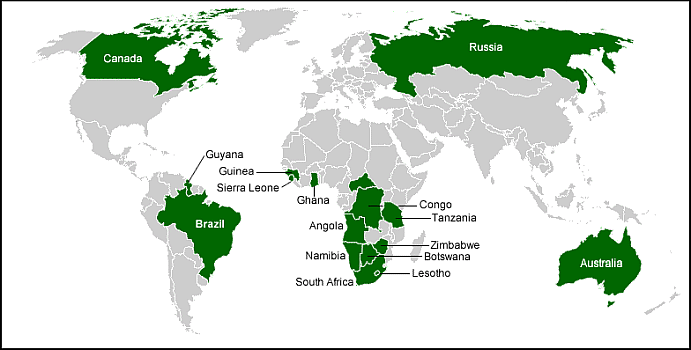
Green is used to indicate diamond producing countries.
Ehud Arye Laniado
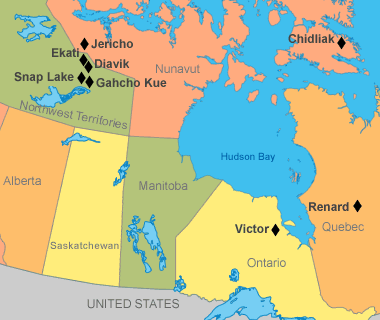
Main diamond mines in Canada
Geology.com
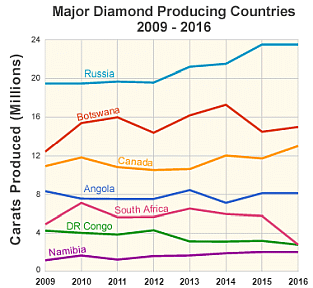
Not only is Canada the third largest producer in terms of volume, but also by value.
Part of the reason that Canadian diamonds are highly valued is that they are not “conflict” or “blood” diamonds. These diamonds are mined in war zones and used to finance rebel armies. World attention was brought to this issue as a result of the 2006 Leonardo DiCaprio film, Blood Diamond. In addition to diamonds, the most commonly mined conflict minerals include those used by multinational electronics companies (cassiterite for tin, wolframite for tungsten, coltan for tantalum, and gold ore). These are harvested in Africa and used to make our smartphones and other electronics.
Read the Time article, Blood Diamonds, to see what efforts have been made to control the ways and people who operate diamond mines.
If you want to visit any links in the following pdf, right click and select "Open Link in New Tab" to avoid leaving this page.
Here in Canada the issue is not the abuse of the men and boys forced to labour in brutal conditions and long days for very little pay. Mines in Canada are found in northern Ontario, Nunavut and the Northwest Territories. In addition, new deposits in northern Saskatchewan's “Star-Orion South” project are on the verge of development. In a twist of geographical fate, these mines are in parts of Canada where the poorest citizens live. In many cases these mines are found in aboriginal traditional land. Read Joseph Boyden’s article, The true tragedy of Attawapiskat, about the people of Attawapiskat Ontario.
If you want to visit any links in the following pdf, right click and select "Open Link in New Tab" to avoid leaving this page.
Certainly not conflict diamonds, but is all the wealth from these stones going to the right people? Now that the end is in sight for the Victor mine, what will happen to the ravaged land, or to the jobs that the few local people did have? The mine is reported to have sold in the order of $2.5 billion. What is the “right” level of compensation for the people of Attawapiskat, or other indigenous communities where kimberlite pipes suggest incredible riches below?
This is a google map image of the Victor Diamond Mine in Northern Ontario.
Google Maps
This is a closeup google map image of the Victor Diamond Mine in Northern Ontario.
Google Maps
Now, the best that can be done is to negotiate a place for the community in the reclamation work that will happen after the last of the mining is completed.
For now DeBeers moves on to capitalize on the deposits in the Northwest Territories.
If you want to visit any links in the following pdf, right click and select "Open Link in New Tab" to avoid leaving this page.
 The Diamond Dilemma
The Diamond Dilemma
Develop your conclusion about the diamond industry, and the interrelationship between the place diamonds have for consumers of high-end jewelry and the people who mine them. In your conclusion, compose and share two questions you need answered in order to propose a way forward for the diamond industry or for the people of Attawapiskat. Explain the importance or relevance of your questions in an effort to understand these issues more deeply.
What we need is a paradigm shift. Consumerism is not necessarily bad for the environment or for the people who make or buy consumer goods if we change the system we have now. Need a paradigm shift? Think back to Naomi Klein questioning the role of capitalism on climate change. She was not advocating that we get rid of markets, but that we look to those places that are making sustainable futures a reality.
Does consumerism and materialism equate with happier lives or a sustainable future? Is there a different way of thinking and acting?
Another way of looking out for the people engaged in this process is ethical consumerism. This occurs when consumers make their purchases only after evaluating and avoiding products and services found to have had a negative impact on society or the environment. So what does that look like? Study the following resources.
If you want to visit any links in the following pdf, right click and select "Open Link in New Tab" to avoid leaving this page.
So, here are some things to think about when pursuing more ethical consumerism:
| Ethical Consumerism Consideration | Possible Response |
| Has this product been produced with child labour? | Just don’t buy it. Buy a chocolate bar that has the Fairtrade logo instead. |
| Which product should I choose? They look pretty similar. | Pick the local option. |
| Has this product been tested on animals? | Find an alternative. |
| Does this product use “conflict” resources? | Find an alternative. |
| Does the company making this product use clearcut forestry techniques and not replant. | Find an alternative. |
| Does this business repeatedly violate environmental stewardship? | Give your business to another company. |
| Do I really need this product? | Buy fewer items that are going to last you longer. |
If you can’t find an alternative to a product that you wish to purchase, make your opposition to these unethical practices known by finding and signing an online petition. Write an email to the company about your concerns and desire for a sustainable future.
Be a leader! When the opportunity arises, talk about what you bought, why you bought it and where you bought it.
What all these steps have in common is that you have to be an educated and alert consumer. You need to do your research, think critically about the data you find and make mindful decisions.
Never doubt that a small group of thoughtful, committed citizens can change the world; indeed, it's the only thing that ever has.
Evidence that there is interest in changing the way we function in our global economy is the growing interest participation in the “sharing economy.”
Most of us have experienced some aspect of a sharing economy. A library, music, a prezi are all forms of sharing. You may live in a community that shares bikes, or even cars. You may have called an Uber or stayed in an Airbnb. A laundromat is another example of a sharing economy that has been around for decades.
Read about the growth of sharing in Amsterdam.
If you want to visit any links in the following pdf, right click and select "Open Link in New Tab" to avoid leaving this page.
Not without some challenges, but the benefits of Peerby seem to be greater than the challenge of sorting out what is meant by sharing. Could this work for you? Prior to the early 1990s (before stores were open on Sundays), borrowing milk, or eggs or a cup of sugar from your neighbour because the grocery store wasn’t open was very common. Now we have apps and the Internet to help us find what we are looking for. According to this graphic the economic benefits suggest that sharing is only going to become more common.
 The Impact of Globalization
The Impact of Globalization
The focus of this activity has been the interrelationship and impact of globalization. Pose and answer a question about consumer responsibility. Your question needs to be open-ended, should be non-Googleable (meaning it requires critical thinking over a factual answer) and the answer should be 200-300 words.
Answer the following three questions:
- What was the most important idea in this activity?
- What was the most valuable resource that was shared in this activity? Explain your reasoning.
- What question(s) do I need to ask so that I can better understand the issue?
